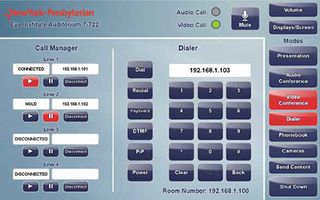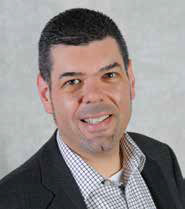Quick Bio
Name: Steve Greenblatt
Title: Founder and President
Company: Control Concepts, Inc.
Over the past 10 years, since InfoComm released the Dashboard for Controls, there have been significant advancements in technology from the minimization of fixed peripherals like physical transport decks and portable media, to BYOD, to soft CODECs that replace hardware-based components, to more software configured devices.
All of these are the results of the new AV/IT world we now live in. We have witnessed the changes, and we tap into the power and creativity that technology advancements give us. What control systems solutions providers and our industry colleagues must also do is remain focused on defining the right solutions for users. The exercise and challenge of finding solutions remains essentially the same. The advanced application of evolving technologies allows us to do so with greater impact.
The Network is the Backbone of AV Systems
From device control to signal transport—whether you remain local to a single room or facility, or span across multiple rooms, the building, or an entire enterprise across the globe—the network is an essential part of the modern AV and control system.
More devices are now controlled and supported by sophisticated APIs that allow those devices to have enhanced capabilities, provide more flexibility and control options, and offer more data. Bi-directional communication with devices is now the norm, rather than the exception. We see more manufacturers supporting RS-232 or IP communication as opposed to IR or other control methods that provide less opportunity for customization and feedback via two-way communication.
The Network Offers More
The network is not only vital to AV system operation, it provides opportunities to go beyond the AV systems for connection to monitoring and asset management software, web control, and IT management like SNMP. By using the network, we are able to provide remote access and help desk, and room management.
Thanks to the support of the network, we have the ability to connect to outside systems, like scheduling software and building control systems. Standard communication protocols like Bacnet and middleware software solutions enable us to communicate between disparate systems.
Increased power and capability comes via the support of outside programming languages like Java, Javascript, and C# that have resources and libraries to tackle challenges that were previously impossible. Every one of these advancements is made possible by the network.
Control systems solutions providers must remain focused on defining the right solutions for users. The advanced application of evolving technologies allows us to do so with greater impact. BYOD is a Game Changer

Mobile devices were barely a thought 10 years ago, and nobody could imagine the effect that they would have on our lives, our industry, and on AV systems. Mobile affects user interface design. It becomes a new presentation tool and can be used as a control interface. The influence of mobile devices has been a game changer.
Furthermore, the idea of touchless automation, where systems can be configured and operated without direct user interaction, one of the most modern concepts. If desired, users can now enter a room and have it automatically turn on or set to a configuration for the expected meeting or application with the trigger of a motion sensor, the connection of a mobile device, or the timed scheduling of a software program. This minimizes interaction with the system and makes control and automation more transparent.
The More Things Change, the More They Remain the Same
Although a lot has changed, and we have made many exciting advancements, the approach and foundation necessary to building successful AV control system projects and programming remains relatively the same.
The exercise of revisiting and modernizing the Dashboard for Controls (the mission of the recently released InfoComm white paper, “Modern Approaches to Control Systems Design”) began by reviewing what was previously done and determining what should be updated, cut, or edited. During this process we confirmed that the basics and building blocks of user interface design, color theory, and human factors are basically the same despite changes in technology. The basic elements and operation of systems remain relatively consistent.
We have always been challenged to define the proper solution, not so much about how to implement it. These days, we can do so much more thanks to the modern advancements I have outlined. Ultimately, this ability to do more magnifies the need to identify and define proper solutions thoroughly and carefully. What remains the same is the responsibility to identify the specific needs of a user in order to provide tailored options and customized solutions. This involves both conversations about their technical needs and assessment of the function of their environment and their organizational culture.
- To arrive at these answers, a good control systems solutions provider asks:
- ** Are the users technical?
- ** Do you have repeat users or will users always be first timers?
- ** How do you plan to support your systems?
- ** Do you have a technical staff or will you provide support through other means?
- ** Are there standard uses of the systems? What have your past experiences been?
- ** Do you have standards to maintain?
This exercise can be completed in a variety of ways, through an interview, focus group, online or in-person demos, client questionnaires, or whatever approach is most effective to gather the information in a clear and agreed upon manner. The results of this process should lead to a functional system description and a scope of work.
To be the most useful, the discussion should not be limited to what is needed today. Rather, it should anticipate future needs, so that provisions can be planned for growth and development. The system functionality and programming needs to be built to allow for modifications without having to go back to the drawing board.
Charting the Course to Meet Expectations and Adapt to Changing Needs
The scope of work, along with the project schedule and budget, must be kept in balance in order to obtain an effective outcome without sacrificing quality or putting anyone in jeopardy.
Additionally, thought should be given to an arrangement for post-project support for user preference changes, adjustments, modifications, and upgrades, as well as a defined agreement for source code ownership.
As we continue to tap into the power of technology, grounded in the relationship between solutions provider and client, we are able to provide the kinds of solutions that meet needs in real ways. With a continued focus on defining solutions and implementing new technologies, the path is clear with regard to the experience and functionality users require now and into the future.











